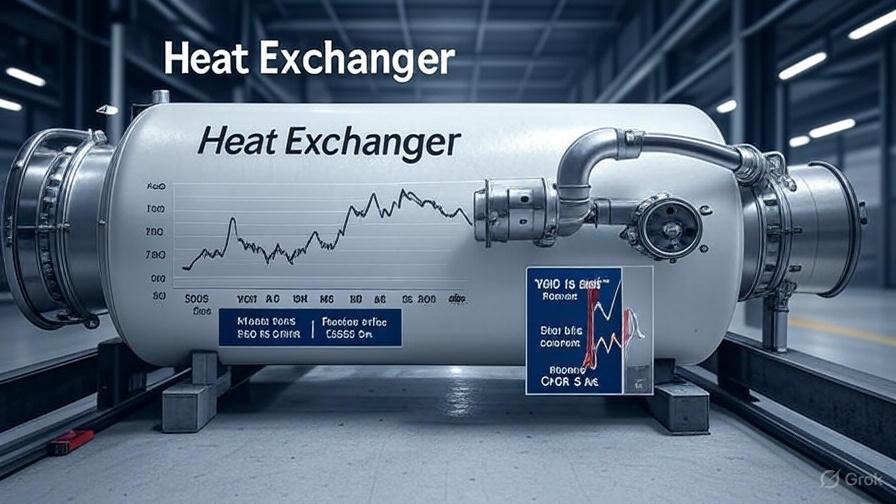Heat Exchanger Market to Hit USD 42.4 Billion by 2035

The heat exchanger market is poised for significant growth, advancing from USD 18.9 billion in 2025 to USD 42.4 billion by 2035 at a steady CAGR of 8.4%. This upward trend reflects the growing demand for energy efficiency, sustainability, and process optimization across diverse industries. From oil and gas to HVAC, chemical processing, and power generation, heat exchangers remain indispensable for maintaining productivity and thermal efficiency in industrial and commercial settings.
The industry’s transformation is not only marked by volume expansion but also by the rise of new technologies that are reshaping performance expectations. Established players continue to anchor the market with their robust systems, while emerging manufacturers are pushing boundaries through advanced designs, digital integration, and eco-friendly solutions.
Full Market Report available for delivery. For purchase or customization, please request here: https://www.futuremarketinsights.com/reports/sample/rep-gb-24840
Shifting Technology Landscape
The evolution of heat exchanger technologies underscores the balance between tradition and innovation. Shell and tube exchangers maintain their dominance, holding a projected 42.7% market share in 2025, due to their proven reliability and wide adoption in refineries and chemical plants. Their robust performance under extreme conditions ensures they remain indispensable in heavy-duty applications.
Plate heat exchangers are witnessing rapid adoption, valued for their space efficiency and modular designs that enable better heat recovery. They are increasingly deployed in HVAC, food processing, and district heating applications. Meanwhile, air-cooled exchangers are gaining traction as industries prioritize water conservation and compliance with environmental standards, particularly in power generation and petrochemical sectors.
Hybrid designs integrating corrosion-resistant materials and advanced geometries further illustrate the market’s pivot toward sustainability and efficiency. These innovations highlight the industry’s focus on minimizing energy losses, cutting downtime, and aligning with global carbon reduction goals.
Industry Trends Driving Growth
The role of heat exchangers in global industries is deeply intertwined with broader trends in energy, manufacturing, and sustainability. Their adoption is shaped by several critical factors:
- Industrial expansion and energy demand: Rising output in chemical processing, power generation, and refining has intensified reliance on heat exchangers for efficient energy transfer.
- Environmental compliance: Stricter regulations are accelerating the replacement of older systems with advanced designs that reduce emissions and enhance efficiency.
- Material innovation: The use of titanium, stainless steel, and nickel alloys has elevated performance in corrosive and high-pressure environments, while lightweight aluminum systems are supporting fuel efficiency in automotive and aerospace sectors.
- Renewable energy integration: Heat exchangers are increasingly essential in geothermal, solar thermal, and biomass projects, extending their influence beyond conventional industrial markets.
Regional Market Insights
Growth prospects vary widely across global markets, with industrialization, infrastructure investments, and regulatory frameworks shaping adoption. China leads with a projected CAGR of 11.3%, fueled by its massive industrial base and push for energy modernization. India follows with 10.5%, backed by rapid expansion in chemical and power generation sectors.
Germany maintains a 9.7% growth rate, supported by strong engineering innovation and its leadership in renewable integration. The UK is advancing steadily at 8.0%, driven by modernization of energy systems and food processing facilities. Meanwhile, the US, at 7.1%, demonstrates stable growth supported by power generation, HVAC, and petrochemical applications.
Competitive Landscape
The competitive environment of the heat exchanger market is defined by a balance between established global players and innovative challengers. ALFA LAVAL, Kelvion Holding GmbH, and SPX FLOW lead with comprehensive portfolios that serve energy, processing, and industrial clients worldwide. IHI Corporation and Xylem stand out with specialized designs focusing on large-scale installations and sustainability.
Danfoss and API Heat Transfer have gained recognition through compact and modular solutions, while FUNKE Wärmeaustauscher, Thermowave, and HISAKA WORKS emphasize engineering excellence in specialized applications. Emerging players such as Accessen Group and Enerquip Thermal Solutions are carving space through localized expertise and cost-effective models.
From Doosan Power Systems and Larsen & Toubro to Thermofin, HRS Heat Exchangers, and Wessels Company, the competitive landscape demonstrates how both seasoned manufacturers and new entrants are contributing to innovation, efficiency, and global expansion.
- Art
- Causes
- Crafts
- Dance
- Drinks
- Film
- Fitness
- Food
- Jeux
- Gardening
- Health
- Domicile
- Literature
- Music
- Networking
- Autre
- Party
- Religion
- Shopping
- Sports
- Theater
- Wellness


